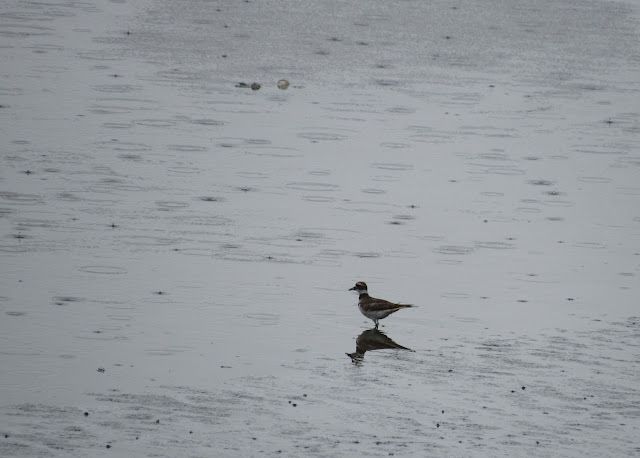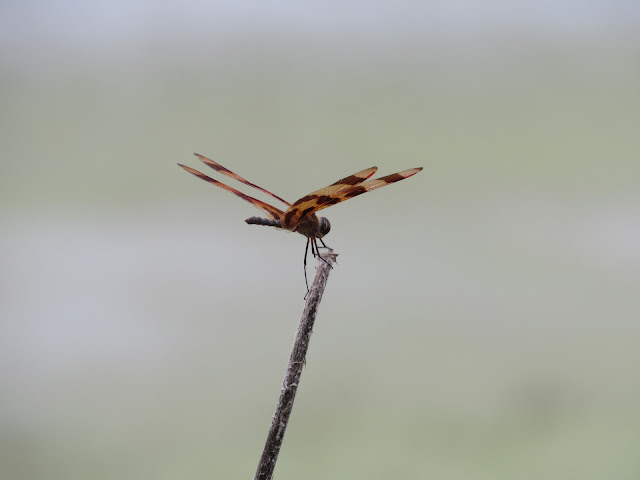(Continued from previous blogpost) I and two friends walked back along the levee, watching as even more American White Pelicans (Pelecanus erythrorhynchos) gathered on a shallow spot in the lake.
It began to rain a bit yet again, and we watched the sandpipers play in the shallows as we walked back to the car. This Killdeer (Charadrius vociferus), like thousands of other shorebirds, foraged on the shallow mudflats of Lake Chautauqua.
With my two friends, I drove on to Goofy Ridge, which I promise is the actual name of the place. According to the linked article, Goofy Ridge was so named because during one of several occasions of drunken tomfoolery, someone shot a walnut off the head of a volunteer. Someone else called it a "d--m goofy thing to do" and the name Goofy Ridge stuck. What made Goofy Ridge notable for us was the tremendous smell and swarm of a hundred Turkey Vultures (Cathartes aura).
I've never seen the sky so filled with vultures as it was, and neither had my two friends.
Of course, the terrible smell and presence of vultures, along with hundreds of gulls, was due to dead carp. There were thousands of dead carp along this end of the lake. I don't know what killed them, but more dying carp could be seen in the lake itself, some floundering into the shallows.
Despite the smell and associated disgust, there were improvements. The weather had let up, and thus the lighting for pictures had improved. Also, the American White Pelicans were a bit closer.
Several perched on nearby rocks, catching fish that swam in the deeper pools nearby.
Unlike the last levee, this one curved back and around. If you wanted to, you could walk the levee over to the banks of the Illinois River and follow the levee on that bank all the way back to the osprey nest and the other levee. That would be exhausting, and so we did not try this.
In the nearby shallows, away from the dead fish, several sandpipers foraged, closer than any before.
Below, I name each of these birds with my best guess as to what they are. With sandpipers, it's guesswork for me, as for some of these birds it's my first time ever seeing them.
Least Sandpiper (Calidris minutilla)
Pectoral Sandpiper (Calidris melanotos) (above and below) (new to me)
Lesser Yellowlegs (Tringa flavipes) (new to me)
Semipalmated Sandpiper (Calidris pusilla) (new to me)
Spotted Sandpiper (Actitis macularius)
On the way back through Goofy Ridge, we saw all of these Turkey Vultures, the ones pictured earlier, perched in a dead tree. There were quite a few more than are visible above.
The vultures had landed to dry off their wings before flying again. These vultures lacked towels, unlike the three of us watching them below. As a result, they had to air-dry themselves, stretching out their wings and basking in the near-sunlight. It was only partially overcast at this point. We drove back to Havana and partook of a local McDonalds before crossing the river and driving to Emiquon.
Emiquon, for the unaware, is a gigantic reconstructed wetland owned by the Nature Conservancy and mostly closed to the public, it seems. At any rate, it is arguably the "best" birding area in all of Central Illinois, a title it trades with Chautauqua depending on the season. Emiquon gets the rarer birds generally, and it is likely the more attractive of the two visually. I leave it to you to decide.
The southern end of Emiquon is the area I know best, having never made it all the way up to the northern end. A large marsh dominates this end, with cattails in the southeastern corner.
Another swamp species was this Solitary Sandpiper (Tringa solitaria), which, true to its name, was by itself. This sandpiper I first saw back in July on the UIS campus, but I didn't report it back then because the photos were rather poor.
Emiquon, while built for birds, is also a great preserve for other animals, including my favorite dragonfly, the Halloween Pennant (Celithemis eponina), named for the orange and black coloration. Considering the first place I ever saw one of these was on a fairly polluted lake in a commercial area on the west side of Springfield, these are not particularly rare. Several of these dragonflies were found as we walked along the levee.
Also not rare, this White-tailed Deer (Odocoileus virginianus) faun ran in front of us as we walked along the levee. This was one of several deer we saw in the swamp. White-tailed Deer prefer the edges of forests, and Illinois, with its patchwork of prairies and forests, has always been a deer-heavy state. However, thanks to a lack of predators and a lack of being hunted for food by all and sundry, White-tailed Deer populations are exploding. They are considered by some sources to be the single greatest threat to our forests. For more information, see this Nature Conservancy article. As a reminder, the Nature Conservancy is the group that owns and manages Emiquon.
On a lighter note, the three of us drove onwards. Considering we hadn't been to the restroom for a few hours, we decided we needed to find a bathroom.
We pulled off the side of the road once or twice, without much success as to wildlife or bathrooms. As a result, we continued onwards to the Dickson Mounds Museum, still bathroom-hunting. In addition to all the nature, there are Native American mounds on the bluffs west of Emiquon. Mounds can be found throughout the Illinois and Mississippi River valleys. As a matter of fact, my mother, who grew up in the Illinois River Valley, had neighbors whose property was the site of an archaeological dig. Dickson Mounds is one of the larger sets of mounds along the Illinois River, and the attached museum is quite a fine place. The bathrooms were especially welcome, being the reason we'd stopped at the museum in the first place. After using them, we decided to tour the museum, where I found this picture, a map of the surrounding area:
Above is this part of the Illinois River Valley, on the cusp of development. Below is how it looked when all the draining, flood prevention, and general development had finished:
Today, the area where it says Thompson Lake Drainage and Levee District is now Emiquon. We left the museum, deciding it was getting about time to start heading back home. On our meandering way back, we stopped off at another slough, where I spotted this Double Crested Cormorant (Phalacrocorax auritus). More to the point, it spotted me, and I got a picture of it as it fled.
I was wrong. The levee was narrow, and my friends were certain they were going to end up in the swamp at some point. "We're going to die!" is exactly what you want to hear as you drive. However, this did not happen, and the drive went fine. Shortly after photographing the Wood Duck (Aix sponsa) above and the Pied-billed Grebe (Podilymbus podiceps) below, a truck appeared behind us. In order to get out of its way, we drove to the turnaround at the end of the road. The truck pulled up beside us, and the man behind the wheel rolled down his window. "Are you lost? Do you need any help?"
Lost? No. Help? Maybe. "No."
A pair of polite questions. "Do you know this is an area closed to the public? Did you see the signs?"
I mean, I had, so... "Yes."
Of course, this demands immediate explanation before I get in MORE trouble. "But it's not quite like that. I though since the gate was open, people were allowed back here. I drove back here a month ago, past an employee, and he didn't seem to care."
The man was quite nice, and in other circumstances I'm certain we could have had quite a nice conversation about birds or Emiquon. However, at this point, I know I screwed up.
"Ok, well, this is actually closed to the public. There's been someone stealing stuff from back here?"
Oh, great. Now I look like a robber. I mean, I've got a camera, a scope, a Peterson field guide, and two friends who would collaborate our story of birding, all in the back of the car. Still, if this man was to call the cops, he'd be legally entitled to, I assume.
To cut the length of this blogpost, the rest of the conversation was this man being quite nice and inquiring what we were up to, and I gave him brief Yes and No's for answers. Whoever you are, I hope I didn't seem too rude to you, and I'd like to apologize if I was. I drove out of the levee, not slowing down to take pictures. We drove back through Havana, spotting another Bald Eagle as we drove over the Illinois River.
One final anecdote: As we entered the town of Kilbourne, I spotted a stand selling fruit in the middle of town. I figured I'd check if they had any peaches or apples to sell. Instead, in this tiny rural town in the wilds of Mason County. they were selling corn, watermelons, and Tillandsia. Tillandsia, also known as air plants, are bromeliads, which are a group plants that grow on trees in the tropics. Generally, these are not found for sale in large quantities in Illinois. I don't know how often you shop for exotic houseplants, but I generally do so in large cities, where they are usually sold. I don't think I've ever bought so exotic a plant in a town where the population is 375 as of the last census. As a result, I bought one to commemorate all of this memorable trip, easily the highlight of August. No matter what happens the rest of this month, I doubt it can compete in oddness with this.
It's hard to believe that the summer's slipped by so fast. It was May only three months ago!































Your Eastern Phoebe photo is actually a Northern Rough-winged Swallow.
ReplyDeleteThanks!
Delete